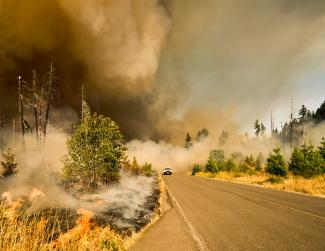Climate change-related stressors are expected to drive the displacement of an estimated 200 million people by 2050. Meeting the needs of millions of cross-border climate migrants is a pressing concern at every level of governance. Although President Joseph Biden’s Executive Order No. 14013 authorized a report on the resettlement of climate-displaced peoples in the context of refugee admissions, the question of whether refugee-protected status can apply to climate migrants is still a matter of international debate (see ELI’s work on climate migration). Domestically, the federal government also needs to pay attention to the related issue of internally displaced people, or those who are forced to leave their homes but remain within the borders of their own country.
As climate change impacts continue to change the landscape of the United States, policies must be put into place to address the needs of millions of Americans forced to move domestically by extreme weather and other stressors. Part 1 of this two-part blog series will provide a background on climate change and internal displacement and underscore the need to develop equitable climate programs. Part 2 will then provide policy recommendations for the federal government to proactively address the challenges of climate-related displacement.
Environment- and disaster-related displacement already affect millions of Americans. In 2020, 30.7 million people worldwide were internally displaced by disasters. Of these, 1.7 million were Americans, almost double the figure from 2019. Wildfires in California displaced 100,000 people from their homes last year. Hurricane Harvey damaged over 270,000 homes and residences in the Greater Houston area. The residents of Isle de Jean Charles, Louisiana, who are participating in a voluntary resettlement project necessitated by severe land loss along Louisiana’s coast, are often called “the first official climate refugees in the United States.”

Internal displacement is caused not only by sudden-onset disasters, but also slow-onset stressors, such as high wet-bulb temperatures, sea-level rise, and land degradation—all of which impact large areas of the United States. Sea-level rise is a particularly significant slow-onset factor; under a 1.8-meter sea-level rise scenario in the United States, scientists predict 13.1 million people will be displaced from coastal areas. Such climate change impacts will push millions to migrate around the country in search of more habitable areas. To address such population shifts, the federal government must take action to proactively reduce the scope of forced displacement and streamline the resettlement process when displacement cannot be avoided.
Any federal action must include a focus on equity, as marginalized communities are disproportionately impacted by climate change—an issue highlighted during the aftermath of Hurricane Katrina. Katrina resulted in the largest environmental forced migration since the Dust Bowl, as 1.5 million residents of Alabama, Louisiana, and Mississippi fled Katrina’s destruction. Forty percent of those who left, primarily Louisianans, were unable to return, and half the residents of New Orleans had not returned to the city even a year after the storm. Primarily Black neighborhoods sustained more damage from the storm, leading to greater displacement and slower return times among Black homeowners. Black residents were also almost seven times more likely to have lost their jobs after the storm, further increasing the difficulty of return and resettlement.
Race, class, housing situation, and other axes of difference all contributed to Katrina’s impact and aftermath. The example of Katrina highlights not only the insufficiency of existing disaster support mechanisms, but also the need for equity considerations to play a greater role in the design of such programs.
